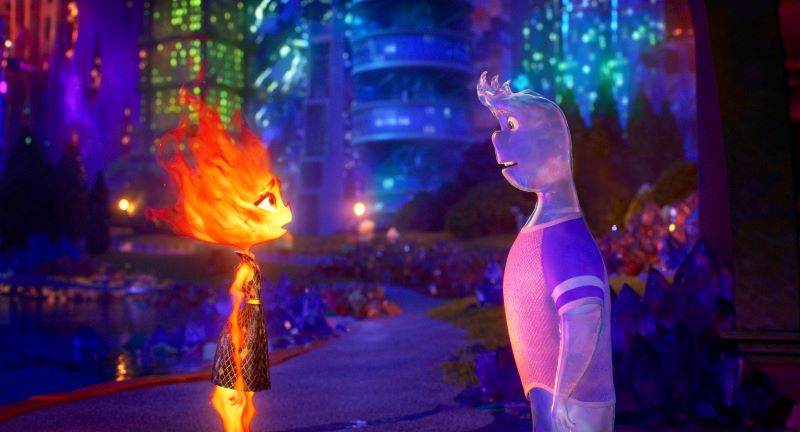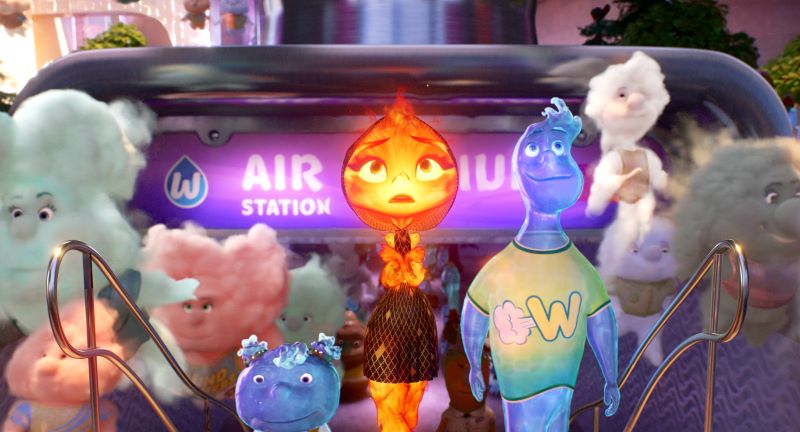Raised in New York by Korean immigrant parents, Peter Sohn started his life in animation when he got a summer job working on Brad Bird’s The Iron Giant. After time spent at The Walt Disney Company and Warner Bros., he found his way to Pixar, where he began working in the art department on Finding Nemo. He made his directorial debut with the 2009 short Partly Cloudy, before helming 2015 feature-length tale The Good Dinosaur.
Now he’s back with Elemental, a story inspired by his own upbringing. Set in the fantasy world of Element City, with characters made from fire, water, earth and air, the film follows Ember (voiced by Leah Lewis). A ‘fire’ person, she lives with her parents and is expected to take over the running of their store, but things change when she meets and falls for Wade Ripple (Mamoudou Athie), a teary-eyed ‘water’ person.
How would you describe your journey through Pixar until now?
“I just see it as just a lot of luck, honestly. And understanding ‘fuel’. That was the thing. I didn’t really understand it then. But now looking back, what is the fuel? What lights your fire? What is the thing that kept driving you? And the love for cinema was the one thing. I know that’s such a cliché, but working at a studio like Pixar, it’s not about your title. It’s just about how can you help the movie become its best thing? People really believe that there and so you’re just offering ideas all the time.
“I first started on Finding Nemo as a sketch artist. And I was just drawing scuba gear and aquariums, but the director saw something that I was adding to the film and said, ‘Come into story’. I’d never done story. And I boarded this whole sequence. And I showed it to Andrew [Stanton], and he trashed it. He just said, ‘No, this is terrible’. And I remember being crushed by it. Like, why did I put my heart into this to just get it stomped on? And then you make a decision: ‘next time I do this, do I put my heart into it?’ And the answer is yes. Even if you get stomped on, it hurts. Like fucking a lot! But for the art of it and for the love of the movies, it’s a benefit, and this was a very similar experience for us – making this thing. You make a movie, you put your heart into it, it can get stomped on. And then, do you do it again? Do you put your heart out? And again, you do. And so, it’s just been years of that lesson throughout all the films that I’ve worked on there.”
When did you start thinking of ideas for Elemental?
“There was the idea of elements that I had even when I was in school. This idea of just a world of elements. But narrative toward it didn’t show up until a moment during the press tour of The Good Dinosaur, where I got to thank my parents at the ceremony. And I was overwhelmed with it. Now, I didn’t even think that was a narrative. It’s when I came back to the studio and they’re asking for ideas, I said that I had several. But then they asked about the trip to New York and I told this anecdote. And they were saying, ‘That’s your next film, Pete’. That’s when it started.”
The development period is so long for animation. Was there ever a point when you felt Elemental was getting away from you?
“Yes, absolutely. I think the first year of this development process my father passed away. And it was a surprise, it came out of nowhere, he had Chronic obstructive pulmonary disease (COPD). His lungs collapsed. And I had already begun an outline with a writer. And once he had passed away, the story got really dark. And I didn’t even see that it was getting dark. This is what I mean – you’re on your own developing it. I was talking to the writer and some of the story artists that it needed to be this way. And when I pitched it, Pete Docter, my executive producer, was very honest with me – [saying] ‘The second outline that you’ve done is so dark’. He knew that I was dealing with my father’s death. And he just asked very innocently, like, ‘Is this what you always wanted with this idea?’ And I said, ‘No, I really wanted something hopeful’. And he said, ‘We should take a little break, and dig back into what that original intent was’. And he was right. So much of this film is tied to the loss of my parents. As I finish the movie, I’m feeling this closure.”
The film also deals with issues of xenophobia. Some viewers might object to this in a family animation film. Could it cause a backlash?
“It might. And I’m not naïve to it nor will I ignore it, but at the same time, the film will speak for itself. So much of the pieces that we put in there really came through empathy and came about through compassion and trying to connect. I’m scared to tell something personal, I’m terrified, it’s not an easy thing to do, because I can get crushed again. But at the same time, with Pixar there’s a safety that Denise [Ream, my producer] and the studio makes so that we can all be compassionate about an idea.”

Love stories in animation aren’t done that often. Were you conscious of that?
“Um, no. There are big aspects of Disney films that have love in them, obviously. All the princess movies, and there’s just so much of that building toward a final kiss or something. And then there was Wall-E, this love story between these two robots. But during the making of this, there is a genre of the romantic comedy that we delved into. But the intent was never to just make a romantic comedy. It was trying to build something that was larger than that. I kept saying, ‘It would be great to have a big summer movie with the heart of an independent film, with romance in it’. And that was my goal as we were going for it. But yeah, I was watching a lot of romantic comedies.”
Like what?
“There were several. Like the different branches of the romantic movies. I loved Sense and Sensibility and what Ang Lee and Emma Thompson had done. I really loved the Norman Jewison [film] Moonstruck and these really flawed characters, and then the world of like Amélie, and what Paris meant. Manhattan and the Woody Allen movies with their characters and how these cities were treated as a backdrop…the wonderful cinematography of those places. But then there were also a lot of culture clash films, like The Big Sick, and My Big Fat Greek Wedding. And then there were the family dramas that I was delving into; even The Godfather Part II because there was an immigration scene.”

The beginning of Elemental really does nod to the Ellis Island opening of Godfather Part II…
“Oh, I’m so glad you noticed that. There was definitely an homage to that opening. I will tell you, Gordon Willis’ cinematography when the Statue of Liberty is revealed behind the ships and then you see a young Vito sitting in quarantine with that reflection of the Statue of Liberty in there…I get very emotional because I think about my father. I got a few of these stories before he passed away…when he came to the U.S. on his own, without knowing the language, without having any money, without having any connections. He was one of the first Korean grocers – one of six Korean grocers – in Manhattan.”
What was the biggest challenge on Elemental from an animation standpoint?
“I mean, we’ve done toys, which are hard plastic. We’ve done cars with the metal, they don’t move. But these characters just are constantly moving. If you ever pause in a frame of this film, they look weird. It just looks strange when you pause them. These are the first characters that we’ve ever done that they look right when they’re in movement, and they’re constantly moving. And in the design of these characters, at every turn, when we’re building them, you would be shocked at how horrifying a fire character can be. When you made it so real, it looked like something out of Lord of the Rings. It was like a demon! So it had to be about control.”
Elemental is in cinemas from June 15, 2023
https://www.filmink.com.au/its-elemental/”>
#Elemental #FilmInk
